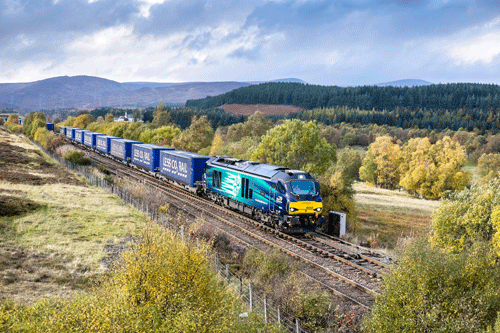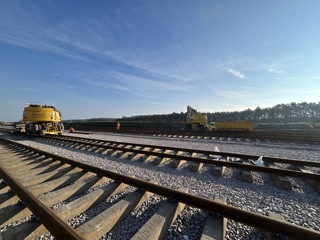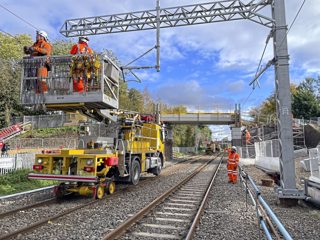Questions are being asked about the future of Scottish freight.
Transport Scotland says that people and communities rely on rail freight - it is part of their everyday lives, with mail, parcels, goods and consumables all transported on the iron road.
The industry in Scotland carries goods worth more than £30 billion per annum, ranging from high-end whisky to produce for supermarket shelves.
In 2013/2014 around 14 million tonnes of freight was transported by five freight operating companies (FOCs) - DB Schenker, Freightliner, GB Railfreight, Direct Rail Services and Colas Rail. This figure is predicted to rise to 26 million tonnes by 2043.
There is also a £30 million Scottish Strategic Rail Freight Investment Fund that is ring-fenced and governed by the industry.
But set against this apparent good health, there are also concerns. The coal market is dying. Currently two million tonnes of coal are transported by rail in Scotland each year, but that is predicted to fall to just 500,000 tonnes by 2020. And that prediction was made before the news on November 18 that all coal-fired power stations will close by 2025, with restricted use by 2023 (RAIL 789).
Data from Scottish Transport Statistics reveals that between 2002 and 2006 the movement of minerals - predominantly coal - accounted for between 75% and 80% of the total rail freight market in Scotland. This market share has fallen to around 50%.
When the decision regarding the power stations was made, GB Railfreight Managing Director John Smith said that it would place rail freight at an “important crossroads”.
He adds: “The closure of coal stations raises considerable challenges for the rail freight industry. A reduction in coal has long been anticipated and is clearly important to help the UK meet its carbon targets.
“However, coal stations are closing sooner than intended due to the impact of the carbon tax regime. Together with the demise of the UK’s steel industry, the rail freight sector is seeing the reduction of bulk commodities that have been the core of our business and allowed us to speculate in other markets.”
Overall, rail freight has been in a dark place in recent months. Figures from the Office of Rail and Road released on November 25 show that freight lifted totalled 21.1 million tonnes during the three-month period from July-September 2015. This is down 18.4% on the corresponding period last year (RAIL 789). There were declines in all but two of the seven main markets, with the amount of coal moved dropping a massive 61.6%. The only areas showing growth were domestic intermodal and construction.
Even so, despite the strong growth in the intermodal market, the decline of coal contributed to a net reduction in the total rail freight market of around 40%.
These are worrying times, and it is against this backdrop that Transport Scotland issued its Delivering the Goods: Consultation towards Scotland’s Rail Freight Strategy document, which asks the industry to provide its views on the market.
Writing in the foreword, Scottish Minister for Transport and Islands Derek Mackay states: “This is undoubtedly a challenging time for the rail freight industry in Scotland. Its predominant market, coal, is declining rapidly with the closure of Longannet and reductions in flows to power stations in England.”
Longannet Power Station will close on March 31 2016. Its owner ScottishPower announced earlier this year that the closure was likely, and it confirmed the news in August. It blamed the “need to close” on National Grid’s decision not to award the station a contract for grid balancing services.
It also said that a combination of high carbon taxes and high transmissions charging means running a thermal plant north of the Border was uneconomic. At the same time, ScottishPower also confirmed it would be progressing with developments at Cockenzie for the same reasons.
Despite this, Mackay remains upbeat: “I see a positive, sustainable future for Scottish rail freight, where it plays a significant role in Scotland’s economic growth through providing a safer, greener and more efficient way of transporting products and materials.”
Mackay wants to support the market as it looks to grow through new opportunities, while continuing to develop existing markets.
He adds: “Despite imposed austerity measures by the UK Government, we have a proven track record of investment in our railways with over £5bn committed between 2014-2019, including a £30m Scottish Strategic Rail Freight Investment Fund.”
Page eight of the consultation document states: “Without co-ordinated intervention the rail freight industry in Scotland is likely to severely decline.” It states that this “amplifies the need for other existing markets to grow and new markets to emerge”.
Key to future success, says Mackay, is creating an environment where the industry has space to innovate and work together for the benefit of customers, where companies are clear on the benefits of using rail and where funders are assured of optimum value for their investment.
He acknowledges that there are a number of barriers, but says these are not insurmountable. However, he warns: “The Scottish Government cannot do this alone, particularly in the current fiscal climate. To make this work, we need firm commitment from the rail freight industry and its customers. Not just in words, but also in positive action and investment.”
The Transport Scotland consultation document claims that a vibrant rail freight sector has a vital role in supporting economic growth in Scotland, by supporting increased exports overseas and the efficient movements of goods across Scotland and the UK.
Helping businesses of all sizes to grow is also something rail freight can do. TS wants to work with the rail freight industry to particularly focus on small to medium-sized businesses, to grow their existing markets and access new ones.
The organisation highlights that each freight train can remove up to 76 heavy goods vehicles from the roads (although it doesn’t specify the size of the train). It also highlights that per tonne of cargo, rail freight produces 76% less carbon dioxide than road freight. It also emits less than one-tenth of the nitrogen oxide and fine particulates of road haulage per tonne.
The Scottish Government believes that a shift from road to rail freight, where this is viable, can help meet European Union targets for modal shift from road to rail of 30% by 2030, and 50% by 2050 for distances of more than 300 kilometres (187 miles).
Scotland can also become an attractive place to invest for companies, according to Transport Scotland. It says rail freight has a proven track record of moving goods efficiently, which helps “create underlying conditions” that attracts businesses.
The consultation document includes a map of Scotland showing that there are 40 strategic and supplementary freight sites across the country. Most are located in the Central Belt, but there is a spread - for example, there are terminals in Inverness and Aberdeen, and a depot between the two cities in Keith. The furthest south is Auchinleck, which is deemed a strategic freight site.
So how does Scotland create the platform for growth and tackle the challenges the industry faces?
Transport Scotland cites “substantial natural resources, a highly skilled workforce, a long-standing reputation for innovation, an internationally recognised brand, sectors and companies that are competing at the highest level of international markets (particularly in the oil and gas and food and drink sectors), and exciting developments in emerging sectors such as offshore renewables”.
TS states: “To secure any modal shift and the long-term future of rail freight in Scotland, rail needs to be able to compete effectively with the use of road by heavy goods vehicles. Freight customers want a competitive price to transport their goods and a reliable and consistent service. The roads network is generally always accessible for freight.”
It suggests that some markets are simply not viable for rail freight traffic, and yet there are others (TS highlights transporting heavy bulk goods in long trains over even comparatively short distances) that remain a key strength and market opportunity for the sector.
However, between these extremes there’s a margin where strategic intervention can help change the relative economics between rail and other modes, and where an equivalent level of service can be offered.
The predicted rise to 26 million tonnes carried by 2043 is extracted from Network Rail’s Freight Market Study, published two years ago. However, at that time, the pace and severity of the coal sector decline was not known. TS suggests other markets have also shown a decline, although it believes that the predictions “do provide a useful indicator of the full market potential for rail freight in Scotland if certain conditions were met”.
So where are the market opportunities? TS believes that a number of opportunities for growth exist “where Scotland may hold a competitive advantage”. It highlights timber, whisky, bottled water, fish and meat, or where alternative forms of energy supplies such as biomass are required.
It also highlights that if freight is to grow, then new and expanded sub-sectors must be explored. These include intermodal markets, where TS says the potential for future growth is clear.
However, that depends on reducing the mileage threshold at which rail is competitive with road, while also supporting increased collaboration across modes.
Scotland has annual sales of food and drink of £8.3bn, and there is a suggestion that elements of this market remain untapped by rail, such as fish and meat. Currently a third of all finished whisky products move by rail, but TS believes that can grow. A trial was recently carried out moving spirits to Elgin, showing that this is possible.
Forestry products is another area for growth prospects. Every year millions of tonnes of timber travel across Scotland and beyond, and commercial forestry covers almost 14% of Scotland’s land area. There is a Scottish Government target to continue expanding the forest resource by 100,000 hectares by 2022.
Transporting timber is vital, yet the journey often starts on rural roads, and it is vital that all opportunities are sought to change this. Transport Scotland says that where there are economies of scale, rail can play a part.
Of course, rail access plays a part in this not always being possible, with feedback suggesting that in some rural regions access is difficult. The Highland Timber Transport group highlighted this and wants to use rail, but costs and infrastructure constraints have been cited as barriers. This is where innovation could help, but so far no details have emerged (although all parties are working on solutions).
In construction there is an unprecedented number of projects being delivered in Scotland, and Transport Scotland believes this is a huge opportunity for rail.
Elsewhere, TS says low-bulk haulage merits investigation. It suggests that parcels and food and drink products could be carried on passenger trains, particularly on key inter-city routes. It highlights the transportation of fresh shellfish on the Caledonian Sleeper from Inverness to London Euston.
“Building on examples like this could serve to complement growth in online shopping and the current expansion in parcel service providers in and around railway stations and major hubs across the country,” states TS.
It further highlights the possibilities thrown up by the use of ScotRail’s High Speed Train fleet from 2018, as well as Caledonian Sleeper’s new fleet of Mk 5s. “Within the scope of the Franchise Agreements we will work closely with the franchisees and the business community to explore the feasibility of potential options,” it states.
International markets are also key. Scottish international exports in 2013, excluding oil and gas, were provisionally estimated at £27.9bn, an increase of 7.2% from 2012. The largest exporting industries in 2013, as in previous years, were manufacture of food and beverages (18% of all exports) and manufacture of coke, refined petroleum and chemical products (12.6%).
Just under half of exports were destined for within the European Union, with the Netherlands the largest market, followed by Germany. There is not yet a clear picture as to how much moves by rail.
TS states: “Rail freight movements within Scotland cannot be considered in isolation. Current connections with the rest of the UK, the port network and Europe are crucial both now and to achieve growth potential.”
There is a concern that ports with access to rail do not use the market, while other ports have limited access. There are also no direct trains to the Channel Tunnel, due to insufficient volumes and technical constraints. This is deemed a lost opportunity.
Scottish Government research also reveals a lack of awareness among Scottish businesses, particularly small to medium-sized enterprises, about the potential benefits of using rail freight and how to access providers. Evidence suggests there is also a perception that accessing rail freight services is complex, particularly compared with the ease of putting a lorry onto the road network. TS says this echoes comments received from the rail industry itself.
Scottish Government wants freight to grow on rail…but these are challenging times. It won‘t be easy.
- This feature was published in RAIL 790 on December 23 2015


















FrankH - 09/02/2016 15:13
Coal from Scotland is down to a bare minimum now. Hunterston - Drax 1 usually, sometimes 2 trains a day. Killoch - Pennyfford (cement works) is as and when needed. Fiddlers Ferry trains have ceased. When Drax converts another generator to biomass Hunterston supplies will stop as Tyne/Immingham terminals are closer.